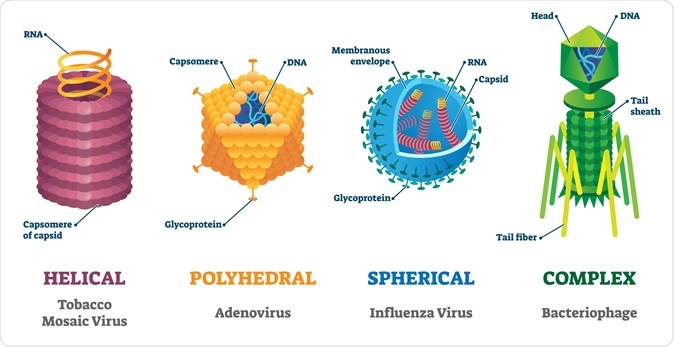A virus is a small infectious agent that replicates only inside the living cells of an organism. Viruses can infect all types of life forms, from animals and plants to microorganisms, including bacteria and archaea.
After many years of study by many brilliant individuals around the world, we have come to understand some of the fundamental nature of the viruses. Despite this, there are many mysteries about viruses that linger, baffling scientists on how they can evade the immune system. Understanding this critical concept is especially imperative today, amid the novel coronavirus outbreak that is running rampant across the globe.
One of the most exciting mysteries today is how viruses circumvent energy barriers to form symmetric shells.
A new study led by physicist Roya Zandi from the University of California, Riverside, is a step closer to solving the mystery. The researchers unveiled that interaction of energies at the molecular levels paves the way for forming a shell, called the capsid, which protects its nucleic acid genome – DNA or RNA.

Photo shows, from left to right, Sanaz Panahandeh, Roya Zandi, and Siyu Li. Image Credit: Zandi lab, UC Riverside.
The viral shell, which is highly symmetric, protects the virus. Hence, understanding the factors that contribute to the assembly of the virus can help health experts block replication of the virus and, eventually, infection.
"Understanding the combined effect of elastic energy, genome-protein interaction, and protein concentration in the viral assembly constitutes the breakthrough of our work," Prof. Zandi explained.
What is a protein shell?
A virus, which is considered a tiny parasite, cannot reproduce on its own. It needs to attack into a susceptible cell. Once it accesses the cells in the body as its host, it can become a viral factory that replicates uncontrollably. Most viruses have either RNA or DNA as their genetic material. The inside part of the virus is called a virion, which is the infectious virus particle. Meanwhile, the outer shell of protein is the capsid.

Types of viruses. Helical, polyhedral, spherical and complex structure models. Image Credit: VectorMine / Shutterstock
Capsid formation is a crucial step in viral infection, which can either be conical or cylindrical. In most cases, it can assume the shape of an icosahedral structure, similar to a soccer ball. This type of shape has 30 sides, 20 faces, and 12 vertices.
For years, it is still not well understood how viruses assemble, since they are minimal. Viruses measure in nanometers, which is one-billionth of a meter. Further, viral assembly is fast, usually occurring within milliseconds.
During assembly, viral shells form into symmetric figures, and if one defect forms, it breaks down the symmetry.
However, the researchers emphasized that because there is limited data, the virus assembly process is not well understood. But, the new study has revealed that the elastic properties of viral shells, capsid proteins, and the interaction between then work together to form energetically stable and highly symmetric shapes.
Zandi explained that by fine-tuning the parameters, they could control the final structure and stability of viral capsids. The team also found that the viral shell can also become a vessel for drugs to be distributed throughout the body.
With the new findings, the researchers hope that new treatments become available to fight viral infections. They urge fellow scientists to design drugs that interfere or block viral assembly.
This way, diseases can be stemmed, including the dreaded coronavirus that has spread across the globe and infected more than 118,000 in two months. So far, there had been more than 4,200 people who had died due to COVID-19. It has spread to more than 100 countries, spurring international panic on the effects of the infection among older adults, who are most vulnerable to the disease.

SARS coronavirus schematic diagram. Novel Coronavirus 2019. 2019-nCoV. Image Credit: Moomchak V. Design
The new coronavirus has affected many people, impacted the economy, and caused panic. It is essential to know how to block viral effects and potential infections.
Journal reference:
How a Virus Circumvents Energy Barriers to Form Symmetric Shells, Sanaz Panahandeh, Siyu Li, Laurent Marichal, Rafael Leite Rubim, Guillaume Tresset, Roya Zandi, ACS Nano 2020, March 2, 2020 https://doi.org/10.1021/acsnano.9b08354